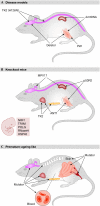Mouse models of mitochondrial DNA defects and their relevance for human disease
- PMID: 19148224
- PMCID: PMC2637315
- DOI: 10.1038/embor.2008.242
Mouse models of mitochondrial DNA defects and their relevance for human disease
Abstract
Qualitative and quantitative changes in mitochondrial DNA (mtDNA) have been shown to be common causes of inherited neurodegenerative and muscular diseases, and have also been implicated in ageing. These diseases can be caused by primary mtDNA mutations, or by defects in nuclear-encoded mtDNA maintenance proteins that cause secondary mtDNA mutagenesis or instability. Furthermore, it has been proposed that mtDNA copy number affects cellular tolerance to environmental stress. However, the mechanisms that regulate mtDNA copy number and the tissue-specific consequences of mtDNA mutations are largely unknown. As post-mitotic tissues differ greatly from proliferating cultured cells in their need for mtDNA maintenance, and as most mitochondrial diseases affect post-mitotic cell types, the mouse is an important model in which to study mtDNA defects. Here, we review recently developed mouse models, and their contribution to our knowledge of mtDNA maintenance and its role in disease.
Figures



Similar articles
-
Defects in mitochondrial DNA replication and human disease.Crit Rev Biochem Mol Biol. 2012 Jan-Feb;47(1):64-74. doi: 10.3109/10409238.2011.632763. Crit Rev Biochem Mol Biol. 2012. PMID: 22176657 Free PMC article. Review.
-
Clinical, pathological and genetic spectrum in 89 cases of mitochondrial progressive external ophthalmoplegia.J Med Genet. 2020 Sep;57(9):643-646. doi: 10.1136/jmedgenet-2019-106649. Epub 2020 Mar 11. J Med Genet. 2020. PMID: 32161153
-
Clinical and molecular aspects of diseases of mitochondrial DNA instability.Chang Gung Med J. 2009 Jul-Aug;32(4):354-69. Chang Gung Med J. 2009. PMID: 19664342 Review.
-
Human mitochondrial DNA replication machinery and disease.Curr Opin Genet Dev. 2016 Jun;38:52-62. doi: 10.1016/j.gde.2016.03.005. Epub 2016 Apr 9. Curr Opin Genet Dev. 2016. PMID: 27065468 Free PMC article. Review.
-
[Mitochondrial disease and mitochondrial DNA depletion syndromes].Acta Neurol Taiwan. 2009 Dec;18(4):287-95. Acta Neurol Taiwan. 2009. PMID: 20329599 Review. Chinese.
Cited by
-
POLG2 disease variants: analyses reveal a dominant negative heterodimer, altered mitochondrial localization and impaired respiratory capacity.Hum Mol Genet. 2015 Sep 15;24(18):5184-97. doi: 10.1093/hmg/ddv240. Epub 2015 Jun 29. Hum Mol Genet. 2015. PMID: 26123486 Free PMC article.
-
The pursuit of precision mitochondrial medicine: Harnessing preclinical cellular and animal models to optimize mitochondrial disease therapeutic discovery.J Inherit Metab Dis. 2021 Mar;44(2):312-324. doi: 10.1002/jimd.12319. Epub 2020 Nov 2. J Inherit Metab Dis. 2021. PMID: 33006762 Free PMC article. Review.
-
Oxygenomics in environmental stress.Redox Rep. 2010;15(3):98-114. doi: 10.1179/174329210X12650506623843. Redox Rep. 2010. PMID: 20594413 Free PMC article. Review.
-
Nutritional Interventions for Mitochondrial OXPHOS Deficiencies: Mechanisms and Model Systems.Annu Rev Pathol. 2018 Jan 24;13:163-191. doi: 10.1146/annurev-pathol-020117-043644. Epub 2017 Nov 3. Annu Rev Pathol. 2018. PMID: 29099651 Free PMC article. Review.
-
A cytoplasmic suppressor of a nuclear mutation affecting mitochondrial functions in Drosophila.Genetics. 2012 Oct;192(2):483-93. doi: 10.1534/genetics.112.143719. Epub 2012 Jul 30. Genetics. 2012. PMID: 22851652 Free PMC article.
References
-
- Anderson S et al. (1981) Sequence and organization of the human mitochondrial genome. Nature 290: 457–465 - PubMed
-
- Battersby BJ, Loredo-Osti JC, Shoubridge EA (2003) Nuclear genetic control of mitochondrial DNA segregation. Nat Genet 33: 183–186 - PubMed
-
- Battersby BJ, Redpath ME, Shoubridge EA (2005) Mitochondrial DNA segregation in hematopoietic lineages does not depend on MHC presentation of mitochondrially encoded peptides. Hum Mol Genet 14: 2587–2594 - PubMed
-
- Bourdon A et al. (2007) Mutation of RRM2B, encoding p53-controlled ribonucleotide reductase (p53R2), causes severe mitochondrial DNA depletion. Nat Genet 39: 776–780 - PubMed
Publication types
MeSH terms
Substances
LinkOut - more resources
Full Text Sources
Medical
Molecular Biology Databases
Research Materials

